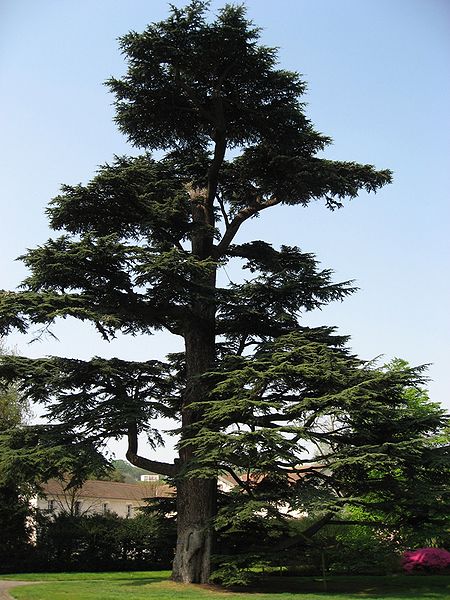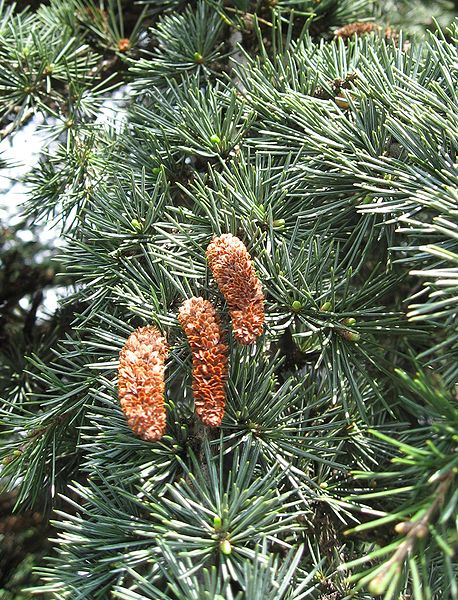 |
|
http://commons.wikimedia.org/wiki/User:Liné1 |
 |
| http://commons.wikimedia.org/wiki/User:Liné1 |
Translate this page:
Summary
Bloom Color: Brown, Purple. Form: Pyramidal.
Physical Characteristics

 Cedrus libani is an evergreen Tree growing to 30 m (98ft) by 15 m (49ft) at a slow rate.
Cedrus libani is an evergreen Tree growing to 30 m (98ft) by 15 m (49ft) at a slow rate.
See above for USDA hardiness. It is hardy to UK zone 5. It is in leaf all year, in flower from October to November, and the seeds ripen from October to December. The species is monoecious (individual flowers are either male or female, but both sexes can be found on the same plant) and is pollinated by Wind.
Suitable for: light (sandy), medium (loamy) and heavy (clay) soils and prefers well-drained soil. Suitable pH: mildly acid, neutral and basic (mildly alkaline) soils and can grow in very alkaline soils.
It cannot grow in the shade. It prefers dry or moist soil and can tolerate drought. It cannot tolerate atmospheric pollution.
UK Hardiness Map
US Hardiness Map
Synonyms
C. libanitica.
Plant Habitats
Woodland Garden Canopy;
Edible Uses
Edible Parts: Manna
Edible Uses:
A manna is obtained from the tree[2, 105]. No more details were given in the report.
References More on Edible Uses
Medicinal Uses
Plants For A Future can not take any responsibility for any adverse effects from the use of plants. Always seek advice from a professional before using a plant medicinally.
Antiseptic Expectorant
The leaves and the wood are antiseptic and expectorant. They act to disinfect the respiratory tract[254].
References More on Medicinal Uses
The Bookshop: Edible Plant Books
Our Latest books on Perennial Plants For Food Forests and Permaculture Gardens in paperback or digital formats.

Edible Tropical Plants
Food Forest Plants for Hotter Conditions: 250+ Plants For Tropical Food Forests & Permaculture Gardens.
More

Edible Temperate Plants
Plants for Your Food Forest: 500 Plants for Temperate Food Forests & Permaculture Gardens.
More

More Books
PFAF have eight books available in paperback and digital formats. Browse the shop for more information.
Shop Now
Other Uses
Essential Resin Wood
An oil similar to turpentine is obtained from the wood[46, 61]. An essential oil from the wood is used in perfumery[61]. Wood - moderately hard, durable. Used for construction[1, 46, 61]. The wood is extremely durable and retains its delightful fragrance for many years[245].
Special Uses
Espalier Scented Plants
References More on Other Uses
Cultivation details
Landscape Uses:Espalier, Pest tolerant, Specimen. Thrives on most soils, being very tolerant of chalk, dry sites and of drought when it is established[11, 81, 200]. Prefers a rich loam or a sandy clay in full sun[1]. Succeeds in warm dry areas with less than 40cm of rain a year, but also in areas with cool summers and up to 200cm of rain[200]. Very intolerant of atmospheric pollution[11, 81]. Small trees less than 50cm tall establish much quicker and better than taller trees, those more than 2 metres tall are difficult to establish[200]. Larger trees will check badly and hardly put on any growth for several years. This also badly affects root development and wind resistance[200]. Fairly slow growing, trees rarely average more than 30cm increase in height per year[185]. Trees can be very long lived, to 300 years or more[185]. There are several named varieties selected for their ornamental value[188]. Small male cones are formed on the lower branches of trees, whilst the larger female cones are formed on higher branches[238]. These female cones persist on the tree for 2 - 3 years before breaking up[238]. Trees are notably susceptible to honey fungus[81, 200]. The trees have a broad canopy and tend to hold any falling snow. This can lead to branches being broken by the weight of snow[81]. Special Features:
Not North American native, Inconspicuous flowers or blooms.
References Carbon Farming Information and Carbon Sequestration Information
Temperature Converter
Type a value in the Celsius field to convert the value to Fahrenheit:
Fahrenheit:
The PFAF Bookshop
Plants For A Future have a number of books available in paperback and digital form. Book titles include Edible Plants, Edible Perennials, Edible Trees,Edible Shrubs, Woodland Gardening, and Temperate Food Forest Plants. Our new book is Food Forest Plants For Hotter Conditions (Tropical and Sub-Tropical).
Shop Now
Plant Propagation
Seed - collect the cones in winter and keep in a warm room until they open[1]. Sow immediately in a cold frame[78]. One report says that a short cold stratification of one month improves germination rates[113]. Keep the seed pot moist, but be careful because the young seedlings are very prone to damp off, keep them well ventilated[113]. Prick out the seedlings into individual pots when they are large enough to handle. Grow them on in a cold frame for their first winter and plant them out into their permanent positions in late spring or early summer. Give them some protection from winter cold for their first winter or two outdoors[K]. Cuttings of terminal shoots can be tried in a frame in November but they are very difficult[113].
Other Names
If available other names are mentioned here
Native Range
TEMPERATE ASIA: Cyprus (Mt. Triphylos), Lebanon, Syria, Turkey (southeast)
Weed Potential
Right plant wrong place. We are currently updating this section.
Please note that a plant may be invasive in one area but may not in your area so it's worth checking.
Conservation Status
IUCN Red List of Threatened Plants Status :

Growth: S = slow M = medium F = fast. Soil: L = light (sandy) M = medium H = heavy (clay). pH: A = acid N = neutral B = basic (alkaline). Shade: F = full shade S = semi-shade N = no shade. Moisture: D = dry M = Moist We = wet Wa = water.
Now available:
Food Forest Plants for Mediterranean Conditions
350+ Perennial Plants For Mediterranean and Drier Food Forests and Permaculture Gardens.
[Paperback and eBook]
This is the third in Plants For A Future's series of plant guides for food forests tailored to
specific climate zones. Following volumes on temperate and tropical ecosystems, this book focuses
on species suited to Mediterranean conditions—regions with hot, dry summers and cool, wet winters,
often facing the added challenge of climate change.
Read More
Expert comment
Author
A.Rich.
Botanical References
11200
Links / References
For a list of references used on this page please go here
Readers comment
| Add a comment |
|
If you have important information about this plant that may help other users please add a comment or link below. Only comments or links that are felt to be directly relevant to a plant will be included. If you think a comment/link or information contained on this page is inaccurate or misleading we would welcome your feedback at [email protected]. If you have questions about a plant please use the Forum on this website as we do not have the resources to answer questions ourselves.
* Please note: the comments by website users are not necessarily those held by PFAF and may give misleading or inaccurate information.
To leave a comment please Register or login here All comments need to be approved so will not appear immediately.
|
|